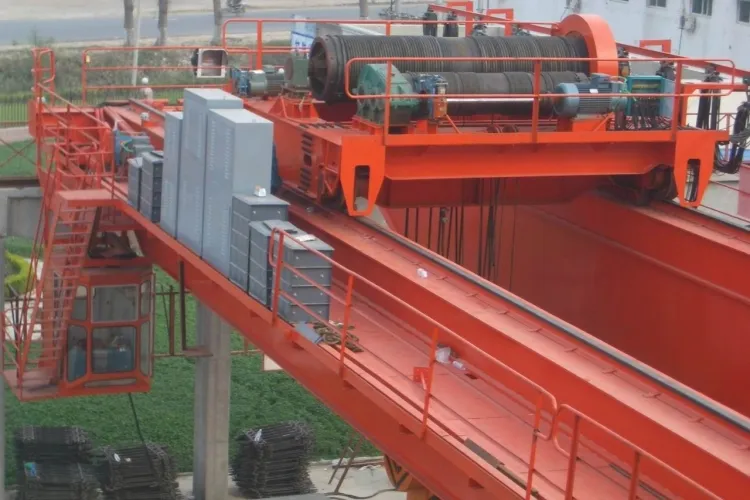- Jan 24, 2025
- News
Cranes and Hoists in Hazardous Areas
Ensure safe and efficient crane operation with cranes and hoists designed for hazardous areas. Yuantai crane can operate safely in hazardous environments.
Cranes are commonly used in many manufacturing industries, which is due to the fact that cranes can assist in the transportation of heavy materials or goods. Sometimes some special industries also need cranes, such as the oil industry, cranes play an important role in crude oil processing, equipment installation and maintenance, dangerous goods handling and other work processes. But part of the industry operating environment is more dangerous, the need for professional cranes to ensure workplace safety. This article focuses on cranes and hoists used in hazardous areas.
Understanding Hazardous Areas
A hazardous area refers to any workplace where there is a potential for fire, explosion, or exposure to toxic substances due to the presence of flammable gases, vapors, dust, or other combustible materials. Common industries that encounter such conditions include:
- Chemical and petrochemical plants.
- Oil and gas refineries.
- Grain handling and processing facilities.
- Explosives manufacturing.
Risks of Operating Cranes and Hoists in Hazardous Areas
The use of cranes and hoists in these environments comes with risks such as:
- Explosion Risks: Sparks generated by electrical components or metal-on-metal contact can ignite flammable gases or dust.
- Electrical Hazards: Unprotected electrical systems can create arcs that lead to fires.
- Corrosion: Exposure to chemicals and moisture can deteriorate equipment, leading to mechanical failures.
Understanding these risks is crucial for implementing effective safety measures.
Regulatory Requirements
Compliance with standards like the workplace safety and health (operation of cranes) regulations and ATEX directives ensures equipment is suitable for use in explosive atmospheres. These regulations mandate the use of explosion-proof components and regular inspections to maintain safety.
The Occupational Safety and Health Administration (OSHA) also emphasizes the need for proper training and equipment certifications in hazardous areas.
Specialized Equipment for Hazardous Areas
To ensure safe operation of cranes in hazardous areas and to protect workers, cranes require special design. Yuantai's explosion-proof cranes can operate safely in hazardous environments and are durable and corrosion-resistant. Our explosion-proof cranes and explosion-proof hoists are characterized by the following main features:
1. Explosion-Proof Motors and Components
Motors and electrical components are encased in protective housings to prevent sparks from coming into contact with external elements.
2. Anti-Sparking Materials
Non-sparking materials, such as bronze or copper alloys, are used for components like hooks and gears to minimize the risk of ignition.
3. Sealed Electrical Systems
Sealing electrical systems protects against moisture, dust, and chemicals, reducing the risk of short circuits and corrosion.
Steps for Operating Cranes and Hoists in Hazardous Areas
1. Risk Assessment
Before deploying equipment, conduct a thorough risk assessment to identify potential hazards and evaluate the suitability of the crane or hoist.
2. Routine Inspections and Maintenance
Frequent inspections ensure that equipment remains in optimal condition. Look for signs of wear, corrosion, or damage to explosion-proof components.
3. Operator Training
Operators should be trained to recognize hazards and understand the correct procedures for using cranes and hoists in hazardous areas.
4. Emergency Protocols
Establish clear emergency procedures to address incidents such as fires, explosions, or equipment malfunctions.
5. Environmental Monitoring
Use sensors to detect the presence of flammable gases or dust, enabling timely action to prevent accidents.
Protecting Cranes and Hoists in Explosive Environments
Corrosion Prevention
To combat the effects of chemicals and moisture, apply protective coatings to metal surfaces and use corrosion-resistant materials.
Temperature Control
Ensure that equipment does not overheat by using temperature monitoring systems and cooling mechanisms.
Sealed Bearings and Components
Sealed bearings prevent dust and moisture ingress, extending the lifespan of the equipment.
The Role of Modern Technology in Enhancing Safety
Advances in modern technology have made it easier to operate cranes in hazardous areas, such as remote operation which reduces the possibility of the operator coming into contact with the hazardous area, thus increasing safety. Yuantai's cranes can be equipped with remote control remotes, if you are using cranes in some more dangerous environments, we recommend that you use the safer remote control method. We have been providing crane solutions for gas, refineries, oil companies, grain mills and other flammable and explosive environments for many years, and our cranes have worked well in these environments for many years.
Conclusion
Operating cranes in hazardous areas requires the use of specialized equipment and strict adherence to workplace safety and health (crane operation) regulations. Choosing a safe and high quality explosion-proof crane ensures that your workplace, as well as your workers, are safe and that risks are reduced.





